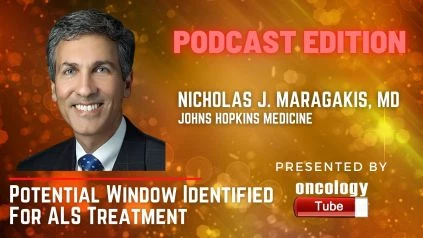Nicholas John Maragakis, MD, Director, ALS Center for Cell Therapy and Regeneration Research, Professor of Neurology at Johns Hopkins Medicine. In this video, he speaks about Johns Hopkins Researchers Identify a Potential Window for Treating ALS, as well as, some cancers.
Amyotrophic lateral sclerosis (ALS) is a neurological condition that affects up to 30,000 people in the United States each year, with 5,000 new cases reported. It gradually weakens muscles, impairing physical function and eventually leading to death. The condition has no single cause and no recognized remedy. However, Johns Hopkins Medicine researchers have discovered a potential window of opportunity during ALS treatment to target astrocyte abnormalities – a subtype of central nervous system cells that provide a structure to physiologically maintain neurons and fine-tune neuron network transmission.
The researchers believe that astrocytes have an active role in the death of motor neurons, which are cells in the brain and spinal cord that allow people to move, speak, swallow, and breathe by transmitting orders from the brain to the muscles that perform these actions.
Researchers analyzed brain and spinal cord tissues from ALS patients in their study, which was published March 21 in the Proceedings of the National Academy of Sciences of the United States of America, and discovered that a specific astrocyte protein, connexin 43, acts as an open pore that sends toxic factors from the astrocytes to the motor neurons. The pore was especially active in ALS patients with a familial history of the disease and those who got the condition sporadically.
The researchers were also able to create stem cell lines from ALS patients and grow them into astrocytes. They discovered that these astrocytes caused motor neuron apoptosis via hemichannels (proteins that provide pathways for the movement of molecules among cells).
According to Maragakis, medicines that can block this hemichannel are being researched. His team demonstrated that tonabersat, a medication originally developed to treat migraine and epilepsy, could inhibit astrocyte-induced motor neuron death in human ALS stem cell lines and animal models during the study.
According to Maragakis, this work adds to the growing body of data showing astrocytes play a role in the spread of ALS. The team will then try to figure out why this hemichannel is especially active in ALS astrocytes, which will give them a better knowledge of how the disease progresses. Maragakis believes it is equally important because it advances his team’s efforts to develop new medications that might block this specific hemichannel, perhaps serving as future ALS therapies.
The ALS Association, the Maryland Stem Cell Research Fund, the Robert Packard Center for ALS Research at Johns Hopkins, the United States Department of Defense, and the National Institutes of Health supported the research.

